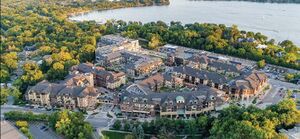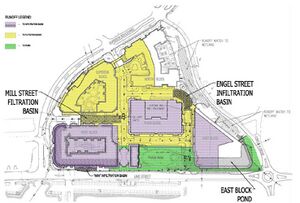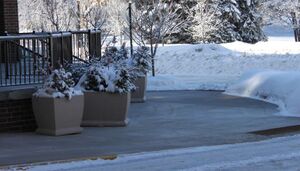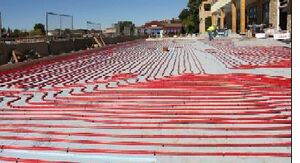
Chloride reduction case study: The Promenade of Wayzata
Increasing chloride concentrations have been observed in groundwater, streams, and lakes throughout the state of Minnesota. The major source of chloride discharge to Minnesota waterbodies is associated with the use of deicing salt products to control ice on road surfaces, parking lots, and sidewalks. Secondary sources of chloride include the use of salt in water softeners and chlorides associated with fertilizer and dust suppressants. Chloride can degrade surface and groundwater sources of drinking water and is a suspected stressor to many forms of freshwater aquatic life. Additionally, chloride can degrade ecosystem health by negatively impacting plant communities and cause structural damage to infrastructure such as bridges and road surfaces. Chloride is a conservative (non-reactive) pollutant and can only be removed through water quality treatment practices such as reverse osmosis, which is prohibitively expensive. For this reason, source reduction (i.e., limiting and reducing chloride use and application) is critical to controlling chloride concentration in Minnesota waters.
The Promenade of Wayzata, completed in 2018, is reportedly the largest redevelopment project completed in the City of Wayzata’s history. The Promenade, located near the north shore of Wayzata Bay off of Lake Street and Superior Boulevard, is a multi-use redevelopment project replacing a shopping mall constructed in the 1960s. The shopping mall was constructed over a 14-acre wetland before Wetland Conservation Act (WCA) regulations were in place. A major goal of the Promenade redevelopment project was to return critical functions of the impacted wetland area through the use of innovative stormwater management and water quality treatment techniques, including under-street infiltration and filtration, a large stormwater wet pond located underneath one of the buildings, green roofs, and a massive network of heated boulevards to eliminate the need for chloride-containing deicing products.
The heated boulevards at the Promenade of Wayzata are accomplished through the use of over 80 miles of hydronic snowmelt tubing located under 5 acres of streets and sidewalks through the redevelopment site. The hydronic snowmelt tubing circulates heated water and propylene glycol (non-toxic anti-freeze) under paved surfaces, raising pavement surface temperature to melt snow and prevent the formation of ice. The former Wayzata Bay Shopping Center had nearly 8 acres of paved surfaces requiring deicing, which was accomplished primarily through the application of chloride-containing rock salt. It is estimated the former site applied nearly 32 tons of rock salt each winter season. Stormwater runoff from the site discharges directly to Wayzata Bay and Minnehaha Creek, which was listed on the Minnesota 2020 Impaired Waters List for chloride impairment. The heated boulevards have eliminated the need for rock salt application where applied, significantly reducing discharge of chloride to Wayzata Bay. In addition, the dry sidewalks and streets reduce accidents and liability from slips on icy surfaces, as well as helping businesses track less salt and moisture into the building thereby prolonging the life of interior surfacing (e.g., carpets). Finally, the elimination of mechanical snow removal reduces wear and tear on the sidewalks and streets themselves, saving maintenance costs.
Development of The Promenade of Wayzata was accomplished by The Wayzata Bay Redevelopment Company, an entity formed by Presbyterian Homes & Services. LHB, Inc. provided master planning, civil engineering, and landscape architecture services. A complete list of entities involved in the redevelopment project is provided, below. An LHB, Inc. project engineer cited that one of the largest challenges posed by this redevelopment project from the perspective of stormwater management was the poor underlying soils and Shallow water table, requiring innovative design and BMP implementation within and underneath paved surfaces and on roof surfaces. A key lesson learned related to the implementation of storm water runoff reduction practices was the importance of performing thorough soil and hydrologic investigation. Soil quality for infiltration varied widely across the site. For this reason, more borings than anticipated were needed to design storm water volume control practices.
For more information related to The Promenade of Wayzata redevelopment project, contact Jim Tiggelaar, PE, CCS, LEED AP, Senior Project Manager at LHB, Inc.: jim.tiggelaar@LHBcorp.com
Project Location: Wayzata, MN near the intersection of Lake Street and Wayzata Boulevard.
Completion Date: Phase 1: 2011 to 2014; Phase 2: 2013 to 2015, and Phase 3: 2015 to 2018.
Entities Involved:
- Master developer for four of six blocks: The Wayzata Bay Redevelopment Company, an entity formed by Presbyterian Homes & Services.
- Master planning, civil engineering, and landscape architecture services: LHB, Inc.
- Geotechnical, environmental, and construction testing services: American Engineering Testing, Inc.
- Structural engineering and infrastructure: Ericksen Roed & Associates.
- Mechanical-electrical-plumbing (MEP) engineering, geothermal, and hydronic snowmelt systems: Karges-Falconbridge, Inc.
- Sub-developer for two of six blocks: Bohland Companies.
Project Cost: $70M and 46,000 hours.
Quantitative Outcomes:
- Chloride: estimated reduction of over 32 tons of rock salt per year.
- Storm water flow rates: 60% decrease for 1-year storm, 40% decrease for 10-year storm, 31% decrease for 100-year storm.
- Storm water volume reduction: 32% decrease for 1-year storm, 20% decrease for 10-year storm, 15% decrease for 100-year storm. Approximately 4 million gallons infiltrated annually.
- TSS reduction: 5,500 pounds annual reduction (89% removal).
- TP reduction: 19 pounds annual reduction (72% removal).
This page was last edited on 11 January 2023, at 15:23.




